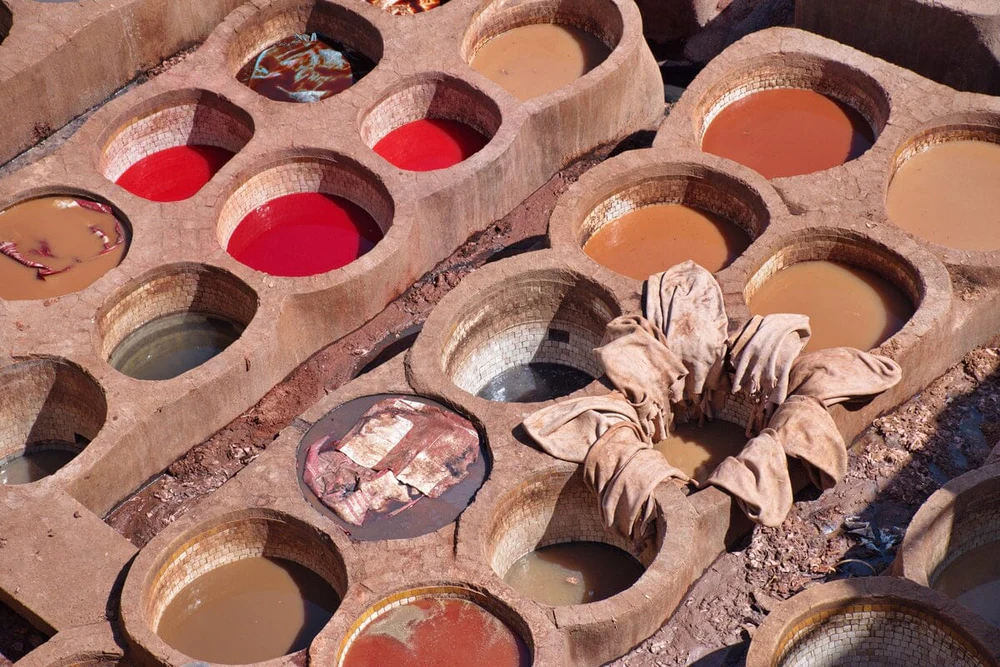So, you think leather tanning is just a simple process of turning raw hides into luxurious leather? Well, you’re in for a surprise. Today, we’re going to explore the world of leather tanning and uncover the 5 best modern techniques that have revolutionized this age-old practice.
From the traditional vegetable tanning to the innovative combination tanning, each method offers its own unique advantages. But, before we dive into the details, let’s take a moment to appreciate the craftsmanship and creativity behind these remarkable techniques.
Trust me, you won’t want to miss what’s coming next.
Vegetable Tanning
In vegetable tanning, you immerse the leather hides in a solution made from natural plant materials to achieve a durable and eco-friendly tanned leather. This method has several benefits compared to other tanning techniques.
Firstly, vegetable-tanned leather is known for its natural and earthy appearance, giving it a unique charm. It also develops a rich patina over time, making it even more appealing.
Moreover, this process uses only organic materials, making it an environmentally friendly choice. The plant-based tanning solution is free from harmful chemicals, such as chromium, which can be found in other tanning methods and can have negative effects on the environment and human health.
Additionally, vegetable tanning enhances the leather’s strength and durability, ensuring that it can withstand the test of time. The process involves slowly and gradually tanning the hides, allowing the leather to retain its natural characteristics and texture.
Chrome Tanning
Chrome tanning is a widely-used and highly efficient method for transforming raw hides into durable and versatile leather products. This technique involves using chromium salts, specifically chromium sulfate, to tan the hides. One of the main benefits of chrome tanning is its ability to produce leather that’s soft, supple, and resistant to water and heat. It also allows for the production of a wide range of leather types, from full-grain to corrected grain.
Additionally, chrome tanned leather has a shorter production time compared to other tanning methods, making it a cost-effective option for manufacturers.
However, it’s important to consider the environmental impact of chrome tanning. Chromium salts used in this process can be toxic and have the potential to harm the environment if not properly managed. Effluent from tanneries that use chrome tanning can contain high levels of chromium, which can pollute water sources and harm aquatic life.
To address this issue, many tanneries have implemented strict waste management systems and technologies to minimize the release of chromium into the environment. Additionally, there are ongoing research and development efforts to find alternative tanning methods that are more environmentally friendly.
Synthetic Tanning
Synthetic tanning offers a sustainable and innovative alternative to traditional chrome tanning methods, revolutionizing the leather industry. Here are three advantages of synthetic tanning and a comparison between synthetic tanning and traditional methods:
Environmental Impact:
- Synthetic tanning reduces the environmental impact associated with traditional tanning methods.
- Unlike chrome tanning, which uses toxic chemicals that can contaminate water sources and harm the ecosystem, synthetic tanning relies on eco-friendly substances that are biodegradable.
- This reduces the carbon footprint and ensures a cleaner and safer manufacturing process.
Consistency and Quality:
- Synthetic tanning provides a more consistent and high-quality end product.
- Traditional tanning methods can result in variations in leather quality due to differences in raw materials, climate, and processing techniques.
- In contrast, synthetic tanning allows for greater control over the tanning process, resulting in leather with uniform texture, color, and durability.
Cost-effectiveness:
- Synthetic tanning can be more cost-effective than traditional methods.
- While chrome tanning requires the use of expensive chemicals and extensive processing,
- Synthetic tanning utilizes readily available raw materials and streamlined production techniques.
- This reduces production costs and makes synthetic tanning a more affordable option for leather manufacturers.
Wet White Tanning
Now let’s explore another innovative technique in leather tanning: Wet White Tanning.
Wet white tanning is gaining popularity due to its reduced environmental impact compared to traditional tanning methods. This technique uses chrome-free and aldehyde-free chemicals, resulting in a more eco-friendly process.
One of the main advantages of wet white tanning is its environmental impact. It significantly reduces water consumption and eliminates the need for toxic chemicals, making it a more sustainable option. This technique also produces less waste and requires less energy during the production process.
However, wet white tanning also has its disadvantages. One drawback is its higher cost compared to traditional tanning methods. The use of specialized chemicals and equipment adds to the overall production expenses. Additionally, wet white tanning may require longer processing times, affecting the overall efficiency of leather production.
Combination Tanning
Combination tanning offers a versatile and efficient method for producing high-quality leather. This combination tanning process involves the use of both vegetable and chrome tanning agents. Here are three advantages of combination tanning:
- Enhanced durability: The combination of vegetable and chrome tanning agents results in leather that isn’t only soft and supple but also highly durable. The vegetable tanning agents penetrate the leather fibers, making them more resistant to stretching and tearing, while the chrome tanning agents provide additional strength and stability.
- Improved color fastness: One of the significant advantages of combination tanning is its ability to produce leather with excellent color fastness. The vegetable tanning agents ensure that the dye penetrates the leather evenly, resulting in vibrant and long-lasting colors. The chrome tanning agents further enhance the color retention, making the leather less prone to fading or bleeding.
- Increased water resistance: Combination tanned leather exhibits superior water resistance compared to other tanning methods. The vegetable tanning agents create a natural barrier against water, while the chrome tanning agents further enhance this property. This makes combination tanned leather ideal for products that may be exposed to moisture, such as shoes, bags, and upholstery.
